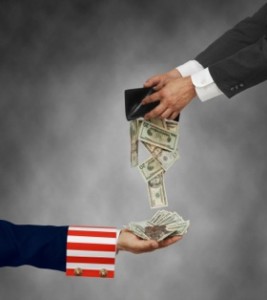 In a new article in the Wall Street Journal, Independent Institute Senior Fellow Richard Vedder and Journal Senior Economics Writer Stephen Moore explain why “Higher Taxes Won’t Reduce the Deficit: History shows that when Congress gets more revenue, the pols spend it”:
In a new article in the Wall Street Journal, Independent Institute Senior Fellow Richard Vedder and Journal Senior Economics Writer Stephen Moore explain why “Higher Taxes Won’t Reduce the Deficit: History shows that when Congress gets more revenue, the pols spend it”:
The draft recommendations of the president’s commission on deficit eduction call for closing popular tax deductions, higher gas taxes and other revenue raisers to drive tax collections up to 21% of GDP from the historical norm of about 18.5%. Another plan, proposed last week by commission member and former Congressional Budget Office director Alice Rivlin, would impose a 6.5% national sales tax on consumers.
The claim here, echoed by endless purveyors of conventional wisdom in Washington, is that these added revenues�potentially a half-trillion dollars a year�will be used to reduce the $8 trillion to $10 trillion deficits in the coming decade. If history is any guide, however, that won’t happen. Instead, Congress will simply spend the money.
In the late 1980s, one of us, Richard Vedder, and Lowell Gallaway of Ohio University co-authored a often-cited research paper for the congressional Joint Economic Committee (known as the $1.58 study) that found that every new dollar of new taxes led to more than one dollar of new spending by Congress. Subsequent revisions of the study over the next decade found similar results.
We’ve updated the research. Using standard statistical analyses that introduce variables to control for business-cycle fluctuations, wars and inflation, we found that over the entire post World War II era through 2009 each dollar of new tax revenue was associated with $1.17 of new spending. Politicians spend the money as fast as it comes in�and a little bit more.
We also looked at different time periods (e.g., 1947-2009 vs. 1959-2009), different financial data (fiscal year federal budget data, as well as calendar year National Income and Product Account data from the Bureau of Economic Analysis), different lag structures (e.g., relating taxes one year to spending change the following year to allow for the time it takes bureaucracies to spend money), different control variables, etc. The alternative models produce different estimates of the tax-spend relationship�between $1.05 and $1.81. But no matter how we configured the data and no matter what variables we examined, higher tax collections never resulted in less spending.
This is exactly the opposite of what the tax-increase lobby in Washington is preaching today. For example, Erskine Bowles, co-chairman of the president’s deficit reduction commission, suggested at a briefing several months ago that there will be $3 of spending cuts for every $1 of tax increases. Sound familiar? Reagan used to complain that he waited his entire presidency for the $3 of spending cuts that Congress promised for every dollar of new taxes he agreed to in 1982. The cuts never came. . . .
Click here to read the full article�